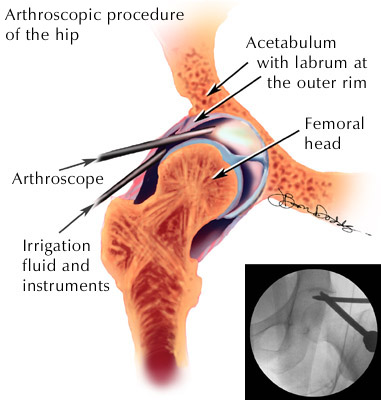
Total Hip Replacement
A total hip replacement is a surgical procedure whereby the diseased cartilage and bone of the hip joint is surgically replaced with artificial materials. Total hip replacement (THR) is an excellent treatment option for people with late-stage degenerative hip disease. THR is one of the most successful and common surgical procedures.
Osteoarthritis of the hip is the most common reason for a total hip replacement. Aging causes wear and tear of the cartilage covering the joint surfaces resulting in great pain and stiffness. This condition is called as Osteoarthritis. Total hip replacement is most commonly used to treat joint failure caused by osteoarthritis
The normal hip joint is a ball and socket joint. The socket is a "C shaped" bone of the pelvis called the acetabulum. The ball is the head of the thigh bone. Total hip joint replacement involves surgical removal of the ball and socket and replacing them with a metal ball and stem inserted into the thigh bone and an artificial plastic cup socket. Inserting the prosthesis (artificial metal ball) into the central core of the thigh bone, it is fixed with bony cement called methyl methacrylate.
In the recent years advancement in medical science has led to use cement less prosthesis (artificial element/ball) which has microscopic pores that allow bony ingrowths from the normal femur into the prosthesis stem. This cement less hip is felt to have a longer duration and is considered especially for younger patients.
A Hip Arthroscopy is a minimally invasive surgical (MIS) procedure used to investigate, diagnose and treat a hip disorder that fails to respond to physiotherapy, medication or other non-surgical treatments. Hip arthroscopy is performed through small incisions using a camera to visualize the inside of a joint. Through small incisions made surgeon will insert a camera into one incision, and small instruments through the other incisions.
sHip Arthroscopy is usually performed in order to investigate the disorder and relieve the patient from hip pain, catching, instability of a hip joint, swelling, clicking. This is an increasingly more common orthopaedic procedure especially for the younger patient with hip problem rather than Hip Resurfacing or Replacement procedure.
In order to investigate and treat sports injuries, work related injuries, arthritis or general inflammation and 'wear and tear'the best procedure is Hip Arthroscopy. The procedure can be performed under General Anaesthetic or Regional Anaesthetic . The procedure usually takes only a short amount of time to perform if the injury is of a minor nature, although repair of more complex injuries can take much longer.
In this procedure two small incisions are made just a small slit on either side of the problematic hip. These two cuts allow a narrow tube with a camera in one tube and in another a slim tube that will regularly inject fluid and rinse the inside of the hip. The injected fluid will allow the surgeon to get a good view of the problem area via the camera lens as he moves it inside the hip joint. Once the problem is identified, another small incision can then be made elsewhere on the hip surface insert exceptionally fine and narrow instruments into the problematic hip joint space. With the help of the clear vision through the camera, the surgeon can then correct the injury or problem with the help of the instrument inserted in the tube. In this procedure there is no need of complex process it's just done in few minutes or hours.
There are two types of hip Arthroscopy
- Therapeutic Arthroscopy: Therapeutic Arthroscopy is the correction of an injury or fault within the hip joint.
- Diagnostic Arthroscopy: Diagnostic Arthroscopy is the investigation to find out what is wrong with a hip joint.
Hip resurfacing is a form of arthroplasty which has been developed as an earlier intervention alternative to total hip replacement (THR). The potential advantages of hip resurfacing include less bone removal (bone preservation), a potentially lower number of hip dislocations due to a relatively larger femoral head size. Surface Hip Replacement surgeon removes only the surface of the damaged femoral head and replaces it with a (relatively) thin shell of metal. Resurfacing has the advantage of preserving the femoral bone stock.
The surgery time for hip surface replacement is slightly longer than that for total hip arthroplasty. The attachment of the acetabular socket is basically the same. It is press-fitted and does not require bone cement. The thigh bone is preserved and not amputated in the initial hip surface replacement surgery; it is available to support a total hip arthroplasty stem. Since the thigh bone is preserved it also aids in the mechanical transfer of weight and stress in a more natural manner. Where THA patients often experience thigh pain, recipients of hip surface replacements avoid that particular discomfort.
The cobalt-chrome cap requires a more precise alignment, and it takes slightly longer to fit. The hole for the pin insertion must be aligned and drilled, and the dome of the femoral head must be shaped to fit the cap. Some bone cement is used to affix the cap, the cap and surface aligned such that bone grows into surface to grip the device
The surface replacement shells are in place. It is obvious that surface hip replacement does not touch the upper part of the thigh bone. The hip joint is restored, the stability and mobility of the new surface replacement hip is disturbed minimally because the dimensions of the artificial ball and cup components are close to the size of the original hip joint.